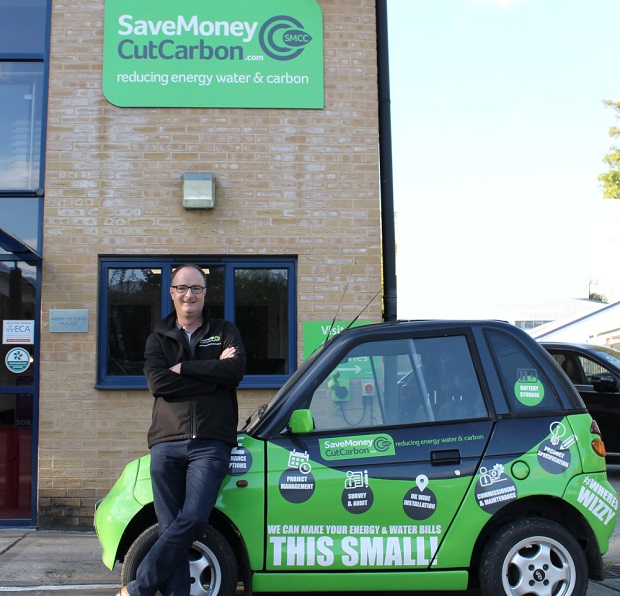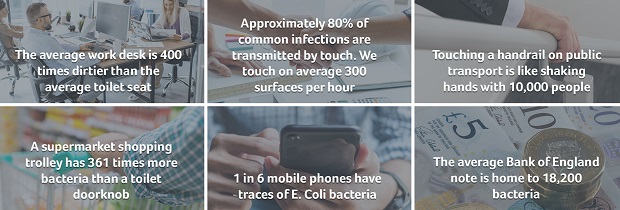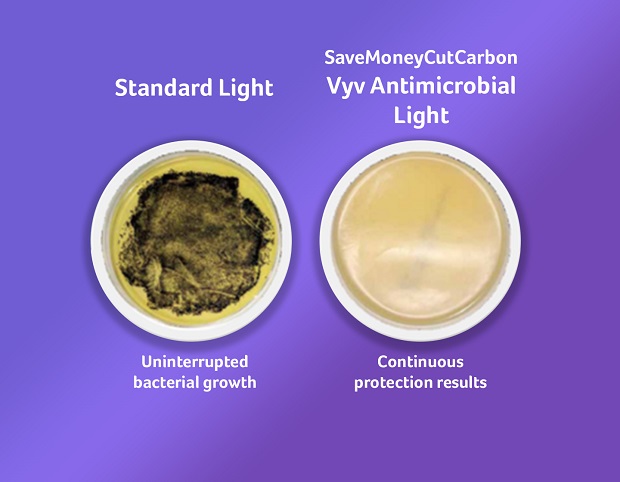Mark Sait is the CEO of SaveMoneyCutCarbon.com
 Fast-paced distribution centres and warehouses have been featured in the news more in the last 6 months than they probably have in the last 6 years.
Fast-paced distribution centres and warehouses have been featured in the news more in the last 6 months than they probably have in the last 6 years.

Why? Because of the online demand for products and services skyrocketing due to lockdown and people feeling uncomfortable with going out shopping.

This significant growth in demand has provided an incredible opportunity for businesses to thrive. But longer opening hours, some working 24/7, will by default mean increased utility bills from energy & water, and with more staff coming and going (hopefully washing their hands more) comes an increased risk from COVID infections spreading quickly, and we are now seeing outbreaks leading to factories & warehouse being temporarily closed.

Health and safety is bread and butter for any warehouse but COVID has changed the conversation. The new demand from legislators, staff and consumers is creating a better working environment; safe, clean, and efficient, so is there a wider opportunity to use this increase in demand to “build back better”?
In this article I want to talk about technologies which can deliver on all three of those demands without needing to introduce a significant shift in how you operate.
When it comes to reducing energy costs or being greener, the mind directly thinks one of two things; change the utility supplier / tariff or the roof space associated with many factories and warehouses – so install solar panels.
Both are proven methods of reducing costs but changing a tariff will only get you so far and solar panels are already on almost every roof that’s suitable, both of which have little impact on the staff working in the building.
Looking up for the solution
So rather than looking up at your warehouse roof, why not look up at the warehouse ceiling? Those heavy, outdated and inefficient lights spread across your facility or warehousing are likely costing you a significant amount of energy and in many cases are delivering poor and dreary light levels for the staff below. Let’s not forget the ongoing maintenance costs too, especially when one goes out and you need to get a scissor lift to go up there.
LED lighting used to be seen as an expensive option, something only for the “big boys” to consider. LED hi bay & low bay lighting as well external loading and road lighting from proven manufacturers such as Ledvance, Thorn and Phillips have quality built in and can deliver:
- 80% reduction in energy costs
- Higher quality of light
- Improved working conditions
- Reduce maintenance costs
Straight away you can tick the box of “making us more efficient” and you’ve started on the “safe” box too. Higher quality lighting, if designed and specified correctly for the different areas, provides a safer working environment and reduces dark spots throughout your facility.
Choosing an LED brand is a bit like walking into Burger King (other fast food restaurants are available) and asking for meat – the choice is endless but there’s a risk you’ll walk out with something vegan.
To ensure you get something that meets your requirement, consider:
- Do you recognise the manufacturer as a proven and trusted brand – once the new lights are up you don’t want failures and the hassle linked to getting suppliers back
- Your business case is going to be based on energy saving and length of life. Can you measure this saving and if you do get a problem is the manufacturer going to honour and support the fix? Try sending an LED light back to China is it fails or getting the small electrical install company to keep coming out to implement a fix. You don’t want to get stuck between an installer, the local electrical wholesaler and a manufacturer in China all blaming each other!
- Can they integrate with smart controls? (more on this further down)
- Are they the right light for the right space, a lighting design that looks at the spacing, height and beam angles is important – one size does not fit all.
- Are they easy to install, leading to cheaper installation and can they be easily moved or have the outputs changed if the work below changes in the future?
If you choose the right brand, get the correct design and specification and have them installed correctly in the most-effective way, you’ll see that your new energy savings will pay for themselves in a matter of months.
Getting Smart & Hygienic
You’ve decided on upgrading the lighting throughout your warehouses with LED lighting, but now you’re thinking “can I save more”?
Yes, you can.
Smart lighting controls, such as timers, dimmers and motion sensors should be always considered, but also many lighting options can now give you ultimate and real time controls. No one could have foreseen the COVID crisis – warehouses and factories have had to ramp up, change and adapt so you want to make sure the lighting can change with you by simply reaching for the iPad or phone, not needing contractors to revisit, especially in lockdowns. They can greatly reduce your energy usage. But they also help improve the workplace and your flexibility to adapt and change quickly as demand dictates, ticking another box.
With certain manufacturers, you can create lighting zones that provide light at certain times of the day or when motion is detected, e.g. maybe some of the warehouse is working nights and other areas not. To go a step further, you can allow staff to dim individual lights when needed or to have automatic settings linked to what is going on below at that point in time. Put these together and you can have customised lighting based on certain shift patterns, providing your staff with the ability to set the lighting in a way that suits them and helps them focus.
To sum up the lighting technology, I recommend you do a walkthrough of all your warehouse space and make a note of how many lights there are, if they need to be turned on at that moment in time, if they’re operating correctly and if there are any dark spots but also lights that are on when they don’t need to be. You’ll be surprised at your findings.
Ticking the “clean” box
As already mentioned, with significant growth in the demand of online shopping, your warehouse or factory can’t afford to shut down due to a COVID outbreak. Guarding against a COVID outbreak is all about the people and their behaviour – one of the most difficult thing to manage across staff and visitors.
So just a couple of solutions that I think are newsworthy.
Healthcare, food, hospitality, warehousing & office environments are just some of the sectors set to have access to a revolutionary new continuous use antimicrobial (non-UV) light technology through a newly formed partnership.
US based Vyv have announced a reseller agreement with fast-growing, multi-award winning sustainability platform, SaveMoneyCutCarbon.
Vyv’s ground-breaking technology achieves a new kind of continuous antimicrobial protection for surfaces with the flip of a light switch. We are presently running a serious of field trials so if any readers are interested then please do contact me as we all need to do everything we can to create cleaners more hygienic work environments.
To fight against COVID, people are washing hands more often than ever. Whilst this helps to reduce the risk of bacteria being spread, it’s also increasing the water usage across the UK.
It’s easy to forget that water is a cost. But it’s a significant cost which is increasing. You don’t want to prevent people from accessing water. So, if you want to reduce your usage, add £££s to your bottom line all while providing a clean working environment– then you need to look at the technology behind your water and again see opportunity to reduce your water bills but also add additional safety and wellness opportunities
But what has this got to do with providing a “clean” environment, you ask?
I want to tell you about two types of technology which significantly reduce hygiene risk, but also reduce water costs by such a vast amount that the technology eventually pays for itself.
The sense in sensor taps
A very simple to understand piece of technology.
When there’s no need to touch a tap to use it, you’re removing the risk of germs being spread when washing hands.
By using a sensor tap from proven manufacturers such as Grohe and Hansgrohe, you can use aerating technology which reduces the flow rate of tap and instead mixes air with the water to provide adequate water pressure. In short, the taps use less water which equates to cost savings.
What’s more, is that there’s no risk of a tap being left on when it requires motion to turn on/off. So no longer will taps be left running overnight!
Wiping out the airborne spread of nasty toilet germs
Germs in a bathroom are everywhere. On handles, floors, ceilings, light fixtures – just everywhere. A key reason for this shotgun-style spread of bacteria is because of toilets.
Every time a toilet is flushed without the lid being put down; germs become airborne due to the water splashing around. This creates a significant risk of illnesses spreading, especially COVID.
Toilets are a bit of a forgotten technology. Since their invention, the technology hasn’t really changed other than different types of flush buttons. When you think about it, we’ve been able to put a robot on Mars and Elon Musk has launched an electric car into space with a rocket – but we’ve still not managed to perfect the toilet, with a recent report stating that 400 million litres of water a day are wasted due to leaky toilet cisterns, enough to supply 2.8 million people – the populations of Edinburgh, Cardiff, Belfast, Manchester, Sheffield, Liverpool and Bristol combined. When was the last time you checked out the toilets across your organisation?
A new toilet – delivering 84% water savings, 95% less airborne germs and with a typical payback of under 3 years.
A new toilet, called Propelair, is popping up across the UK more and more every day – reducing bacteria and water costs.
Its water saving merits are thanks to it only using 1.5 litres to flush rather than the conventional 7 litres or more. But this incredibly low-flush wouldn’t be possible without a feature which also provides a bacteria-free experience. And that’s called the Close-to-flush technology.
By closing the lid, the toilet creates an airlock. The 1.5 litres of water is then combined with air to provide a powerful flush that will make quick work of human waste.
The requirement for the lid to be closed for it to flush means that none of the shotgun-style bacteria risk is present – significantly improving the cleanliness of restrooms.
Businesses that are installing Propelair throughout their business are seeing a water reduction of 80% – leading to the toilets paying for themselves at a rapid rate.
Funding the no-brainer
Businesses that have carried out all or some of the above have seen huge measured savings on their energy and water bills, making these projects a no-brainer from a P&L perspective but also building back better for staff and customers alike.
If you want to provide a safe, clean, and eco-efficient working environment whilst also reducing operating costs then these are just a couple of my favourite solutions that can tick all the boxes. The feedback I always hear is “great, but how do I fund it?” My answer is always the same, let the utility bills fund it for you and there are lots of ways this can be done, from leases, green loans, rental through to full off balance sheet shared savings partnerships. There really is no reason not to make positive changes for your building, your staff and the planet.
From schools, hospitals, hotels, warehousing operators and public sector organisations to thousands of homes across the country, SaveMoneyCutCarbon’s customers collectively save over 727 million litres of water and 23 million kWh of energy each year, from completed projects and products sold on its online platform. The carbon reduction alone is equivalent to travelling 23.24 million miles in an average petrol car.




Comments are closed.